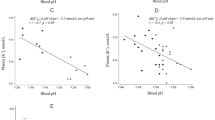Summary
The acidification kinetics of artificial solutions containing buffers of different permeancy were studied in rat proximal tubules by means of stationary microperfusion techniques. Luminal pH changes were measured by antimony microelectrodes and used to calculate net rates of acidification and the approach to steady-state pH levels. For most buffer species, tracer efflux out of the lumen was compared with changes in buffer concentration as derived from calculations based on the Henderson Hasselbalch equation. Steady-state luminal pH was similar for most buffer systems studied. However, secretory hydrogen ion fluxes into the lumen were significantly higher for permeant than for less permeant buffers. The most likely explanation is that permeant buffers behave as “open” systems maintaining constant low diffusible acid levels in the lumen, whereas impermeant buffers behave as “closed” systems in which nonionized acid levels are maintained at higher levels. A behavior consistent with this thesis was directly demonstrated for glycodiazine and, to a lesser degree, for DMO. In contrast, phosphate and creatinine behave like buffers in a “closed” cystem. Characteristics of proximal tubular acidification, of buffer reabsorption, and the effect thereupon of carbonic anhydrase inhibitors are satisfactorily explained by an essential role of (1) hydrogen ion secretion, (2) pK differences, and (3) different permeance of the non-ionized buffer species. However, specific transport mechanisms may, in addition, also contribute to differences in transepithelial buffer movement.
Similar content being viewed by others
References
Al-Awqati, Q. 1978. H+ transport in urinary epithelia.Am. J. Physiol. 235:F77-F88
Brodie, B.B., Kurz, H., Schanker, L.S. 1960. The importance of dissociation constant and lipid-solubility in influencing the passage of drugs into the cerebrospinal fluid.J. Pharmacol. Exp. Ther. 130:20–25
Butler, T.C. 1953. Quantitative studies of the demethylation of trimethadione (tridione).J. Pharmacol. Exp. Ther. 108:11–17
Cassola, A.C., Giebisch, G., Malnic, G. 1977. Mechanisms and components of renal tubular acidification.J. Physiol. (London) 267:601–624
Cassola, A.C., Malnic, G. 1977. Phosphate transfer and tubular pH during renal stopped-flow microperfusion in the rat.Pfluegers Arch. 367:249–255
Cogan, M.G., Maddox, D.A., Warnock, D.G., Lin, E.T., Rector, F.C. 1979. The effect of acetazolamide on bicarbonate reabsorption in the proximal tubule of the rat.Am. J. Physiol. 237:F447–454
De Mello, G.B., Lopes, A.G., Malnic, G. 1976. Conductances, diffusion and streaming potentials in the rat proximal tubule.J. Physiol. (London) 260:553–567
Dennis, V.W., Woodhall, P.B., Robinson, R.R. 1976. Characteristics of phosphate transport in isolated proximal tubule.Am. J. Physiol. 231:979–985
Giebisch, G., Malnic, G., Mello, G.B. de, Mello Aires, M. de 1977. Kinetics of luminal acidification in cortical tubules of the rat kidney.J. Physiol. (London) 267:571–599
Green, R., Giebisch, G. 1975. Some ionic requirements of proximal tubular sodium transport. I. The role of bicarbonate and chloride.Am. J. Physiol. 229:1216–1226
Hodgman, C.D. (editor). 1961. Handbook of Chemistry and Physics. p. 544. Chemical Rubber Publ. Co., Cleveland
Hogben, C.A.M., Tocco, D.J., Brodie, B.B., Schanker, L.S. 1959. On the mechanism of intestinal absorption of drugs.J. Pharmacol. Exp. Ther. 125:275–287
Jackson, M.J., Williamson, A.M., Dombrowski, W.A., Garner, D.E. 1978. Intestinal transport of weak electrolytes. Determinants of influx at the luminal surface.J. Gen. Physiol. 71:301–327
Kramer, M., Hecht, G., Langecker, H., Harwart, A., Richter, K.D., Gluxhuber, C. 1964. Pharmakologie des 2-Benzolsulfonamido-5(methoxy-athoxy)-pyrimidins (Glycodiazin), einer neuen blutzuckersenkenden Verbindung.Arzneimittel Forsch. 14:377–385
Lang, F., Greger, R., Marchand, G.R., Knox, F.G. 1977. Stationary microperfusion study of phosphate reabsorption in proximal and distal nephron segments.Pfluegers Arch. 368:45–48
Malnic, G., Cassola, A.C. 1977. Effect of current-induced transepithelial PD changes on H ion movements in renal tubules.Coll. INSERM 67:53–70
Malnic, G., Giebisch, G. 1979. Cellular aspects of renal tubular acidification. In: Membrane Transport in Biology. Transport Organs, Vol. 4, pp. 299–355. Ch. 6. G. Giebisch, editor. Springer, Berlin
Malnic, G., Mello Aires, M. de 1971. Kinetic study of bicarbonate reabsorption in proximal tubule of the rat.Am. J. Physiol. 220:1759–1767
Malnic, G., Mello Aires, M. de, Mello, G.B. de, Giebisch, G. 1972. Acidification of phosphate buffer in cortical tubules of rat kidney.Pfluegers Arch. 331:275–278
Malnic, G., Mello Aires, M. de, Giebisch, G. 1972. Micropuncture study of renal tubular hydrogen ion transport in the rat.Am. J. Physiol. 222:147–158
Maren, T.H. 1978. Carbon dioxide equilibria in the kidney: The problems of elevated carbon dioxide tension, delayed hydration and disequilibrium pH.Kidney Int. 14:395–405
Mello Aires, M. de, Malnic, G. 1975. Peritubular pH and pCO2 in renal tubular acidification.Am. J. Physiol. 228:1766–1774
Nahas, G.G. 1962. The pharmacology of tris(hydroxy-methyl) aminomethane (THAM).Pharmacol. Rev. 14:447–472
Rector, F.C. 1973. Acidification of the urine.In: Handbook of Physiology, Sect. 8, Renal Physiology. J. Orloff and R.W. Berliner, editors. p. 431–454. American Physiology Society, Washington
Schafer, A., Andreoli, T.E. 1972. Cellular costraints to diffusion. The effect of antidiuretic hormone on water flows in isolated mammlaian collecting tubules.J. Clin. Invest. 51:1264–1278
Ullrich, K.J., Rumrich, G., Baumann, K. 1975. Renal proximal tubular buffer (glycodiazine) transport. Inhomogeneity of local transport rate, dependence on sodium, effect of inhibitors and chronic adaptation.Pfluegers Arch. 357:149–163
Warnock, D.G., Burg, M.B. 1977. Urinary acidification: CO2 transport by the rabbit proximal straight tubule.Am. J. Physiol. 232:F20-F25
Author information
Authors and Affiliations
Rights and permissions
About this article
Cite this article
Costa Silva, V.L., Campiglia, S.S., de Mello Aires, M. et al. Role of luminal buffers in renal tubular acidification. J. Membrain Biol. 63, 13–24 (1981). https://doi.org/10.1007/BF01969441
Received:
Issue Date:
DOI: https://doi.org/10.1007/BF01969441




